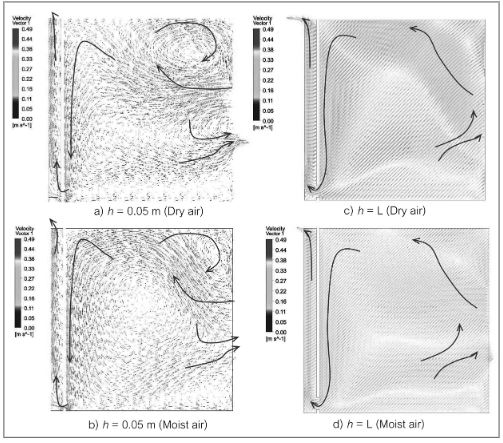Comparison of Ventilation with Moist and Dry Air in the Room Connecting to a Solar Chimney
DOI:
https://doi.org/10.56261/built.v10.117027Keywords:
Natural ventilation, Species transport, Moist air, CFD, Hot humidAbstract
is research aimed to investigate the ventilation rate of solar chimneys installed under dry and humid conditions. Building models for dry air and moist air were constructed in the Computational Fluid Dynamics, ANSYS Fluent 14.0 for numerical calculation of air flow rate and air temperature within the model. This study considered time-dependent turbulent flow and results when the system approaches steady state at 3 minutes. The hot air in the solar chimney was generated by a-constant heat flux of 60 W/m2 in the chimney external wall. The dry-air models applied the Boussinesq’s approximation. The species transport model was used to simulate the moisture content in the moist air. The simulation results showed that temperature of the moist air model was closer to the experiment than the dry air. The ventilation with dry air was lower than that with the moist air due to the reverse flow at the window. This research confirmed the optimum solar chimney ratio of 14: 1, similar to previous researches. In addition, the size of the opening between the building and the chimney highly affected the ventilation of the solar chimney. The best ventilation occurred in the chimney with inlet and outlet, as large as the width of the air space of the chimney.
Downloads
References
ANSYS INC. (2013). ANSYS Fluent theory guide. Pennsylvania, USA.: Author.Cengel, Y. A. (2004). Heat transfer: A practical approach. Singapore: McGraw-Hill.
Chen, Z. D., Bandopadhayay, P., Halldorsson, J., Byrjalsen, C., Heiselberg, P., & Li, Y. (2003). An experimental investigation of a solar chimney model with uniform wall heat flux. Building and Environment, 38(7), 893-906.
Chungloo, S., & Limmeechokchai, B. (2009). Utilization of cool ceiling with roof solar chimney in Thailand: The experimental and numerical analysis. Renewable Energy, 34(3), 623-633.
Gan, G. (1998). Parametric study of Trombe walls for passive cooling of buildings. Energy and Buildings, 27(1), 37-43.
Gan, G. (2006). Simulation of buoyancy-induced flow in opened cavities for natural ventilation. Energy and Buildings, 38(5), 410-420.
Gan, G. (2010). Simulation of buoyancy-driven natural ventilation of buildings-Impact of computational domain. Energy and Buildings, 42, 1290-1300.
Hirunlabh, J., Wachirapuwadon, S., Pratinthong, N., & Khedari, J. (2001). New configuration of a roof solar collector maximizing natural ventilation. Building and Environment, 36(3), 383-391.
Khanal, R., & Lei, C. (2015). A numerical investigation of buoyancy-induced turbulent air flow in an inclined passive wall solar chimney for natural ventilation.Energy and Buildings, 93, 217-226.
Khedari, J., Lertsatithanakorn, Pratinthong, N., Hirunlabh, J. (1998). The modified trombe wall: A simple ventilation means and an efficient insulating material. International Journal of Ambient Energy, 19(2), 104-110.
Maerefat, M., & Haghighi, A. P. (2010). Natural cooling of stand-alone houses using solar chimney and evaporative cooling cavity. Renewable Energy, 35(9), 2040–2052.
Mathur, J., Bansal, N. K., Mathur, S., Jain, M., & Anupma. (2006). Experimental investigations on solar chimney for room ventilation. Solar Energy, 80(8), 927-935.
Rachapradit, N. (2000). Field study of performance of solar chimney with air-conditioned building. Master's Thesis, King Mongkut’s University of Technology Thonburi, Bangkok.
Sudprasert, S., Chinsorranant, C., & Rattanadecho, P. (2016). Numerical study of ventilation in the vertical solar chimney with moist air in a hot and humid climate. International Journal of Heat and Mass Transfer, 102, 645–656.
Xu, Y., Zhou, X., & Cheng, Q. (2015). Performance of a large-scale solar updraft power plant in a moist climate.International Journal of Heat and Mass Transfer, 91, 619–629.

Downloads
Published
How to Cite
Issue
Section
License
Copyright (c) 2017 International Journal of Building, Urban, Interior and Landscape Technology (BUILT)

This work is licensed under a Creative Commons Attribution-NonCommercial-NoDerivatives 4.0 International License.











